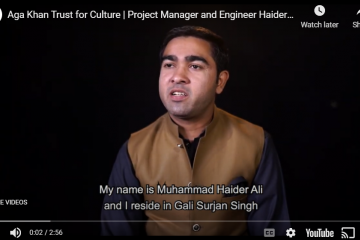AKDN AND
The notion of culture as an asset rather than a luxury is still a contested issue in many parts of the world. As a result, a significant part of the world’s cultural heritage – much of it in the Muslim world – is at risk, as other needs are considered priorities. The central question has been how culture, integrated with more traditional instruments of development, can be used to improve lives in urban, poor and even remote contexts. How can culture provide employment, raise incomes, affect wellbeing, improve health, enhance urban spaces, reinforce a respect for diversity, even restore pride and hope?
For over three decades, the Aga Khan Trust for Culture (AKTC) has shown how culture can be a catalyst for improving the quality of life – in its broadest sense – even in the poorest and most remote areas of the globe. In Bamako, Cairo, Delhi and Kabul, the Network’s urban regeneration projects including the restoration of monuments, the rehabilitation of parks and the creation of new green spaces has provided millions of urban dwellers with a much-needed oasis and restored hope to communities that had become resigned to terminal decline.
Through its programme, the Trust strives to be a catalyst for a better quality of life through: the preservation and revitalisation of cultural assets; the reinvigoration of cultural traditions; the creation of education programmes that foster mutual understanding; and, the identification of architectural excellence that positively impacts the way people live, work and interact.
MoreThirteen of the planet’s 20 fastest growing cities are in areas of the developing world where AKDN works. Ten of those are in Africa.In many of these cities, green space has often been overwhelmed by growth, migration from the countryside and a lack of planning. Encroachment, both legal and illegal, has gradually swallowed up forests and grassland, diminishing green space. Overwhelmed by financial demands, municipalities have neglected the problem, assuming that green space was unproductive and therefore of little value -- or worse, a financial liability.
It is in this context that the Aga Khan Trust for Culture set out to prove that, rather than being financial liabilities, green spaces themselves could be catalysts for positive economic, social and cultural change. In Cairo, Bamako, Kabul, Delhi and other sites, AKTC’s rehabilitation of existing parks and the creation of new parks have made these spaces hugely popular among local populations and international visitors – and are running surpluses.
Twenty years after its founding, with 10 park and garden projects now in the AKTC portfolio, AKTC has demonstrated that parks not only contribute to the quality of life in cities, but that they can be self-sustaining if conceived and managed properly. In several locations, it has even demonstrated that, under the correct conditions, parks and gardens can also be economic generators that drive – directly and indirectly – a broad advance of positive change in terms of social development, local employment, entrepreneurial activity and cultural development.
Museums
Museums are no longer merely repositories of culture, but vital educational institutions that can have a profound effect on public discourse. Museums can testify to the existence of other cultures and faiths in ways that go beyond the written or spoken word. They provide evidence of other realities, other histories and other influences beyond the ones we might have learned or perceived and foster dialogue and promotes tolerance and mutual understanding among people. At their best, museums champion diversity, pluralism, the exchange of ideas and the enrichment of the intellect.
The Aga Khan Museum in Toronto, established in 2014, aims to foster a greater understanding and appreciation of the contributions that Muslim civilisations have made to world heritage. It contains over one thousand artefacts and artworks and spans over one thousand years of history, but it is designed – and curated – to present an overview of the artistic accomplishments of Muslim civilisations from the Iberian Peninsula to China.
In response to a dramatic increase in visitors to Humayun’s Tomb in Delhi, the Aga Khan Trust for Culture is constructing a state-of-the-art site museum at the entrance to the Tomb. The Museum’s aims include a better understanding of Mughal architecture, its associated building craft traditions, and the development of the Nizamuddin area’s pluralist cultural traditions, which defined Hindustani culture for at least five centuries.
>


































